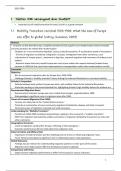2023-2024
1 Teksten IPMI samengevat door ChatGPT
> Important to still read/summarize the texts, but this is a good overview
1.1 Mobility Transition revisited, 1500-1900: What the case of Europe
can offer to global history (Lucassen, 2009)
Abstract
= Criticism on idea that there was a mobility transition & that people in pre-modernization where immobile
and only started to be mobile after modernization
- Emphasis on 'cross-community migration' (across cultural boundaries → acceleration speed of innovation)
- - 6 forms of migration considered: emigration v Europe, immigration from other continents, rural
colonization of 'empty spaces', movement to big cities, seasonal migration and movement of seafarers and
soldiers
- - Research shows that early modal Europe was much more mobile than experts believed (indeed sharp
increase in 1850 but that came from improvements in transportation rather than modernization overall)
Conclusion
Objective:
- Aim to reconstruct migration rates for Europe from 1500-1900.
- Challenge Zelinsky's 'mobility transition' theory linking the Industrial Revolution to increased mobility.
Zelinsky's Perspective:
- Zelinsky believed early modern Europe was static, with mobility linked to the Industrial Revolution.
- Historians working on the period disputed this, highlighting Europe's high mobility before the modern era.
Reconstructed Migration Rates:
- Reconstruction indicates Europe was more mobile than thought, especially before 1800.
- Acknowledges a significant jump in migration rates after 1850.
Causes of Increased Migration (Post-1850)
- Increase not solely due to the 'modernization process.'
- Primarily an acceleration of cross-community migration facilitated by cheaper and faster transport.
- Structural causes of migration remained, but scale increased.
Understanding the "Mobility Transition":
- Period from 1850-1900 considered extraordinary, leading to the concept of a "mobility transition."
- Shift from migration dominated by soldiers and sailors to migration dictated by movements to cities and
other continents
Geographical Variances:
- Levels of migration varied within Europe, reflecting a 'little divergence.'
- Economic performance did not solely determine migration rates.
State Formation and Military Role:
- Importance of state formation and the mobilizing role of armies in influencing migration rates.
- Fiscal–military state played a significant role in mobilizing Europe's male population.
Global Relevance:
- Findings may be relevant for understanding migration patterns in other parts of the world.
- Migration rates might explain different development patterns globally.
Comparisons with China:
- Expect Chinese migration performance to differ from Europe for various indicators.
1
, 2023-2024
- Method for measuring cross-community migration in Europe can be a universal method for global
comparisons.
Call for Further Research:
- Encourages more detailed research on migration patterns and their impact on economic, social, and cultural
aspects.
- Proposes a formal method for measuring migration for global comparisons in various fields of historical
study.
1.2 An introduction to internal migration studies (Martiniello &
Rath)
Main ideas
- Internationale migratie heeft het gezicht v Europa veranderd
- Een vraag die volledig is genegeerd in de debatten over migratie in Europa is de impact van de wereldwijde
crisis en haar Europese incarnaties op migratiebewegingen.
- Het officiële EU-discours over immigratie benadrukt de groeiende behoefte aan nieuwe immigranten om
bij te dragen aan de Europese economische ontwikkeling en de nationale welvaarts- en pensioenstelsels te
ondersteunen.
- Worden individuen en huishoudens gedreven door rationele beslissingen? Of is migratie het gevolg van
historisch bepaalde macrostructurele krachten, met name de toenemende economische ongelijkheid van
het kapitalisme?
Summary of whole article
- The majority (97%) of the world's citizens do not move beyond their native country's borders, with only 3%
being internationally mobile.
- The absolute number of international migrants has increased considerably, from an estimated 150 million
in 2000 to approximately 214 million in 2010.
- Europe received an estimated 72.1 million international migrants in 2010, changing the demographic
landscape of the continent.
- Initial migration catchment areas after World War II were in the advanced economies of north-western
Europe, attracting guest workers from Southern Europe and former colonial areas.
- Over time, Ireland, Spain, Portugal, Greece, Italy, and some Central European countries transformed into
receiving countries and transit countries.
- The impact of the global crisis on outward migratory movements from Europe is a question that has been
overlooked in migration debates.
- There is a distinction between first-generation immigrants and subsequent generations in public and social
scientific discourses.
- European views on immigration are diverse, with some perceiving it as a burden on social cohesion,
security, and public services.
- Immigration laws have become stricter, partly in response to unfavorable political sentiments, to protect
the welfare state and address integration challenges.
- Social scientists in Europe have developed a unique body of knowledge on migration, combining global
influences with local and regional specificities.
- Theoretical perspectives on international migration include neoclassical economics, segmented labor
market theory, dependency theory, world-system theory, and network-driven phenomena.
2




